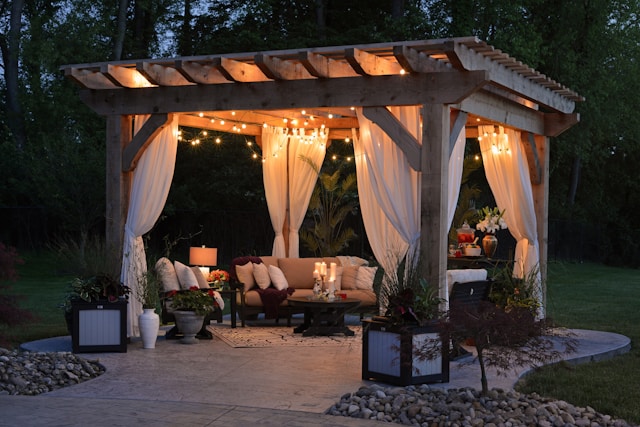A patio is a versatile outdoor space, often paved or decked, that connects seamlessly to a home or building. Depending on its intended purpose and the homeowner’s preferences, it can be open-air or partially covered. Serving as an extension of the living area, a patio can be tailored through a careful selection of furniture, plants, lighting, and decorative accents to cultivate a warm and welcoming atmosphere.
Patios are increasingly becoming a central point of modern outdoor living, offering homeowners a smooth blend of indoor comfort and the natural beauty of their surroundings. As interest in enhancing outdoor environments grows, so does the demand for thoughtfully designed patios. This surge has led to the emergence of skilled patio specialists who combine technical knowledge with creative flair to deliver customised, functional spaces.
The primary purpose of a patio is to create a functional and inviting outdoor living area, serving as a transition zone between the home and the garden, ideal for relaxation, entertainment, and socialising.

What is the Difference Between a Patio and a Veranda?
A veranda is an outdoor structure typically attached to the house, level with the ground floor, featuring a roof that extends along one or more sides. It provides a covered space where homeowners can enjoy the outdoors while being sheltered from the elements. In contrast, a patio is a versatile, paved recreational area that can either be connected to the house or stand independently in the yard. Patios may be open to the sky without a roof or, in some cases, feature coverings such as temporary or fixed umbrellas or canopies for added protection. Both verandas and patios serve as excellent spaces for outdoor entertaining, relaxation, and enjoying the beauty of nature.
What Would a Patio Do For Me?
A patio is more than just a paved area outside the home. It is a seamless extension of indoor living, providing a versatile space for relaxation, entertainment, and everyday enjoyment. From hosting family gatherings and summer braais to enjoying quiet evenings under the stars, patios cater to a wide range of activities. A patio is designed, created and intended for various reasons, some of which are:
- Provides Entertainment Space, which is ideal for hosting gatherings, braais, and outdoor parties, or simply enjoying a drink in the evening.
- Offers a Relaxation Zone for reading, meditation, or enjoying nature.
- Affords a Dining Area. Patios can be equipped with dining tables and seating for alfresco meals.
- Serves as an Outdoor Kitchen. Patios may include built-in braai areas, countertops, fridges and sinks for outdoor cooking and food and beverage cooling.
- Enhances the Garden by providing an attractive space for potted plants, flower beds, and landscaping features.
- Can be used as a Play Area by providing a safe and secure space for children to play outdoors.
- Offers Expanded Living Space. Patios provide additional areas for relaxing, dining, or entertaining, effectively extending the home’s usable space and boosting its overall functionality.
- Increases Property Value. A well-designed patio can add significant value to a home. Outdoor living spaces are highly desirable features for potential buyers, making them a smart and appealing investment.
- Provides a Stronger Connection to Nature by offering a comfortable, accessible way to enjoy the outdoors – whether it’s basking in the sunshine, breathing in fresh air, or simply appreciating the natural surroundings.
- Allows for Flexible Design Options. With a wide range of styles, layouts, and materials to choose from, patios can be tailored to suit individual tastes and complement the home’s architectural style.
- Is Practical. Patios provide a stable, solid surface for outdoor furniture and activities, making it easy to maintain and use.
Designing Your Ideal Patio
When planning a new patio, it’s essential to take the following considerations into account:
- Purpose: How will the patio be used? Whether for dining, lounging, gardening, or entertaining, identifying its primary function will help shape design decisions and ensure it meets your lifestyle needs.
- Size and Layout: The patio should be appropriately scaled to suit both the home and the yard. A thoughtful layout is essential for maximising space, ensuring comfort, and maintaining a smooth flow between indoor and outdoor areas.
- Style: Whether it’s modern, rustic, traditional, or a blend of styles, the patio’s design should reflect the homeowner’s personality while complementing the architectural style of the home.
- Landscaping: Consider incorporating landscaping elements such as plants, ambient and direct lighting, and water features to enhance the overall ambience of the patio space.
What is the Role of Patio Designer and Specialist?
A patio designer/specialist’s role is to create functional and aesthetically pleasing outdoor spaces, focusing on integrating patios and other hardscape elements with the surrounding landscape and the home’s architecture, while considering the client’s needs and preferences. Their services and skills provide:
- Site Assessment
A patio specialist evaluates the specific site conditions, including drainage, sunlight, and landscape integration, to design a patio that maximises usage and minimises potential issues down the line. - Design Expertise and Development
Patio specialists possess a strong understanding of both form and function, allowing them to create detailed plans for patios, walkways, and other hardscape elements that are not only practical but visually harmonious. With a keen eye for design and functionality, they guide homeowners in selecting the most suitable materials, layouts, and styles, ensuring the final result aligns with the client’s needs, preferences, and the surrounding environment. - Optimising Space Usage
By carefully assessing the available area, they strategically design zones for various activities such as dining, lounging, outdoor cooking or children’s play areas. - Material Selection
With a wide range of materials readily available, including concrete, pavers, natural stone, brick, composite decking, and wood, patio specialists help homeowners choose the most suitable options that align with their design vision, budget, and lifestyle. They also consider factors such as durability, maintenance requirements, and how well each material complements the surrounding environment. - Plant Selection
They choose plants that not only enhance the overall design but also add visual appeal, considering factors such as sunlight exposure, soil quality, and local climate conditions. - Lighting Design
They incorporate lighting elements to improve safety, extend usability into the evening hours, and enhance the ambience of the space. - Collaboration with Professionals
They work closely with architects, landscape designers, and contractors to ensure the design is interconnected, aesthetically pleasing and successfully implemented. - Budget Planning and Management
They help clients manage their budgets effectively by finding cost-effective solutions while maintaining the integrity and quality of the design. - Sustainability Practices
They employ sustainable design principles by selecting drought-resistant plants and implementing rainwater harvesting systems to promote environmental responsibility. - Client Engagement
They provide clear and consistent communication with clients helps ensure their needs, preferences, and concerns are addressed throughout the project. - Personalised Design
They tailor the design to align with the client’s individual needs, preferences and style, resulting in a unique and personalised outdoor space which can be used year-round. - Construction Skills
Building a patio requires a certain level of craftsmanship to ensure quality and longevity. Specialists possess the technical skills necessary to execute designs accurately, from proper grading to installation techniques. - Maintenance Advice
After the patio is built, specialists can offer valuable maintenance tips and services, ensuring that the outdoor space remains beautiful and functional for years to come.
Types of Patio Designs and Materials
In South Africa, patio designs vary widely, featuring everything from traditional brick and stone pavers to contemporary concrete and creatively themed outdoor spaces. These patios often integrate elements such as lush greenery, strategic lighting, and outdoor kitchens, allowing homeowners to customise their patios according to their preferred style and functional needs.
For durable and visually appealing patios in South Africa, consider using materials such as natural stone, concrete pavers, brick pavers, or porcelain tiles. Each of these options offers excellent weather resistance and long-lasting performance, making them ideal for the country’s diverse climates.
- Pavers: Made from brick or stone pavers, these patios are known for their durability and classic, clean appearance. They can be laid in a variety of patterns to suit any design style.
- Concrete/Concrete Paving: A cost-effective and highly versatile option, concrete patios can be poured into virtually any shape. They offer a sleek, modern look and perform well in all weather conditions. Can be prone to cracking or settling over time and may require periodic maintenance. Versatile, durable, and cost-effective, available in various colours and textures
- Natural Stone: In South Africa, popular natural stones for patios include sandstone, limestone, bluestone, and slate, known for their durability, aesthetic appeal, and suitability for the local climate. Each piece is unique, adding texture and charm. Granite and quartzite are also known for their durability and can be used in patios, walkways, and driveways. Natural stone can be more expensive and requires proper sealing.
- Porcelain Tile: Elegant, timeless, and these tiles can be used for both indoor and outdoor flooring. They can be slippery when wet and require proper drainage.
- Brick: Brick creates a timeless, traditional look which is perfect for cottage-style, rustic, or heritage-inspired gardens. With proper maintenance, it also offers strength and longevity. Brick patios, a classic and durable option for outdoor spaces, can be designed in various patterns like herringbone, running bond, or basket weave, and are often set on a bed of gravel and sand for easy installation and maintenance. They are often laid in popular patterns such as Herringbone, creating a zig-zag pattern, Running Bond, probably the most common brick pattern, Basketweave, in which pairs of bricks alternate facing up or down, and Circular, a great option for creating a focal point. Clay brick pavers. Clay brick pavers can be more prone to cracking than other materials.
- Cobblestone: Cobblestones provide a distinctive, textured surface that lends a European or old-world character to outdoor spaces. They’re ideal for creating a sense of rustic charm.
- Gravel: A budget-friendly and low-maintenance option, gravel offers excellent drainage. While it may be less comfortable underfoot, it works well in informal or relaxed garden settings.
- Wooden Deck: Wooden decks offer warmth and natural beauty, blending seamlessly with garden surroundings. However, they require regular maintenance to protect against weathering and pests.
- Patterned Paving: Visual interest can be enhanced by pavers laid in creative patterns such as stack bond, stretcher bond, herringbone, or multi-size modular layouts, adding style and personality to the patio.
- Sheltered or Covered Patios: Extend outdoor usability with covered options such as roofed patios, entryways, walkways, pergolas, or freestanding pavilions. These provide shade, protection from the elements and a cozy atmosphere.
- Composite Decking Patios: A low-maintenance, durable, and eco-friendly option for decks, but can be more expensive than some patio finishes.
- Wood: Natural, warm aesthetic, but requires regular treatment to prevent weathering.
- Metal: Modern look, lightweight (aluminium), rust-resistant (stainless steel), but can heat up uncomfortably in the sun.
- Rattan/Wicker: Lightweight, classic outdoor appeal, but may need covers in extreme weather.
- Plastic/Resin: Affordable, lightweight, low maintenance, but may fade over time or become brittle.
Design Ideas
Patios are exceptionally versatile, allowing the homeowner to create a personal space or retreat suited to their particular style and requirements, such as:
- Coastal Oasis: Embrace the coastal vibes with a patio inspired by the ocean, featuring light-coloured furniture, driftwood accents, and sea-themed decor.
- Urban Retreat: Create a modern and stylish patio in an urban setting with sleek furniture, geometric patterns, and minimalist decor.
- Relaxed Paradise: Incorporate vibrant colours, eclectic patterns, and natural elements like plants and rugs to create a bohemian-inspired patio.
- Mediterranean Escape: Design a patio with a Mediterranean feel, featuring terracotta pots, olive trees, bougainvillaea, and a relaxed, inviting atmosphere.
- Tropical Paradise: Create a tropical oasis with lush greenery, palm trees, and bright colours, perfect for a relaxed and vibrant outdoor space.
- Rustic Retreat: Embrace a rustic charm with natural materials like wood, stone, and brick, and add cosy elements like a fire pit.
- Minimalist Haven: Design a simple and uncluttered patio with clean lines, neutral colours, and functional furniture.
- Eclectic Hideaway: Mix and match different styles and elements to create a unique and personal patio.
- Family-Friendly Retreat: Design a patio with a focus on fun and relaxation, featuring play areas, comfortable seating, and a built-in barbecue.
- Entertainment Hub: Create a patio that’s perfect for entertaining, with a large dining area, a bar, and comfortable seating.
Tips for Enhancing Your Patio Space
Make full use of your patio by adding additional elements such as:
- Natural Greenery: Bring your patio to life with potted plants, raised planters, hanging baskets, or vertical gardens. Greenery adds colour, texture, and a sense of tranquillity to any outdoor area.
- Ambient Lighting: Use string lights, lanterns, wall sconces, or solar-powered fixtures to create a warm, inviting atmosphere, perfect for evening gatherings or quiet nights under the stars.
- Comfortable Outdoor Furniture: Choose durable, weather-resistant pieces that offer both style and comfort. Choose furniture that complements the overall design while making your outdoor space truly liveable.
- Outdoor Curtains: Add light, flowing curtains for a soft touch of privacy and to diffuse harsh sunlight. They also contribute to a relaxed, breezy, and elegant vibe.
- Soothing Background Music: Incorporate subtle music with waterproof outdoor speakers or a small portable system to elevate the ambience during outdoor dining or entertaining.
- Custom Soft Seating: Scatter floor cushions, throws, and decorative pillows for extra seating and a cosy, relaxed look. These accents also introduce layers of texture and colour.
- Wicker Accents: Add wicker furniture or accessories for a natural, earthy aesthetic. Wicker blends beautifully with both modern and rustic themes and adds a welcoming warmth to the patio.
- Pops of Colour: Brighten the space with colourful rugs, ornaments, plant pots, and textiles. These personal touches reflect your style and enliven the area.
- Safety and Security: Ensure your patio is a secure retreat by installing outdoor lighting, motion sensors, fences, or discreet alarm systems for added peace of mind.
Conclusion
A patio is much more than just an outdoor space; it serves as an extension of the home that increases both lifestyle and property value. Professional patio designers are essential partners in creating environments that harmonize beauty, functionality, and durability. Whether you are looking to build a new patio or enhance an existing one, investing in expert design guarantees a premium and enjoyable outdoor living experience. Patios provide a fantastic opportunity to expand the liveable area of a home, creating a welcoming space for family and friends to gather and enjoy the outdoors. By partnering with skilled patio specialists, homeowners can bring their visions to life, transforming ordinary backyards into stunning and functional retreats.

